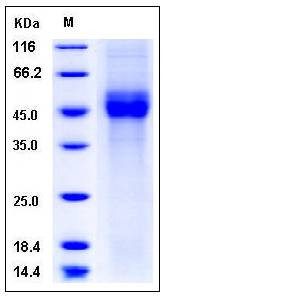Human CD19 / Leu-12 Protein (His Tag)
B4,CVID3
- 100ug (NPP3675) Please inquiry
| Catalog Number | P11880-H08H |
|---|---|
| Organism Species | Human |
| Host | Human Cells |
| Synonyms | B4,CVID3 |
| Molecular Weight | The recombinant human CD19 consists of 283 amino acids and predictes a molecular mass of 31.6 kDa. In SDS-PAGE under reducing conditions, rhCD19 migrates as an approximately 47 kDa band due to glycosylation. |
| predicted N | Pro 20 |
| SDS-PAGE |  |
| Purity | > 90 % as determined by SDS-PAGE |
| Protein Construction | A DNA sequence encoding the human CD19 (P15391) extracellular domain (Met 1-Lys 291) was expressed, with a polyhistidine tag at the C-terminus. |
| Bio-activity | |
| Research Area | Immunology |Adaptive Immunity |B Cell |B Cell CD Antigen |
| Formulation | Lyophilized from sterile PBS, pH 7.4 1. Normally 5 % - 8 % trehalose, mannitol and 0.01% Tween80 are added as protectants before lyophilization. Specific concentrations are included in the hardcopy of COA. |
| Background | The cluster of differentiation (CD) system is commonly used as cell markers in immunophynotyping. Different kinds of cells in the immune system can be identified through the surface CD molecules which associating with the immune function of the cell. There are more than 320 CD unique clusters and subclusters have been identified. Some of the CD molecules serve as receptors or ligands important to the cell through initiating a signal cascade which then alter the behavior of the cell. Some CD proteins do not take part in cell signal process but have other functions such as cell adhesion. Cluster of differentiation 19 (CD19) is a member of CD system. CD19 is a cell surface molecule that assembles with the antigen receptor of B-cells. This results in a descent in threshold for antigen receptor-dependent stimulation. A simplified view holds that the ability of B-cells to respond to the various antigens in a specific and sensitive manner is achieved in the presence of low-affinity antigen receptors. CD19 primarily acts as a B-cell coreceptor in conjunction with CD21 and CD81. The formation of the receptor complex is induced by antigen and CD19, induced by exogenous antigen, has been found cytoplasmic tail phosphorylated and bind to sIg. |
| Reference |
